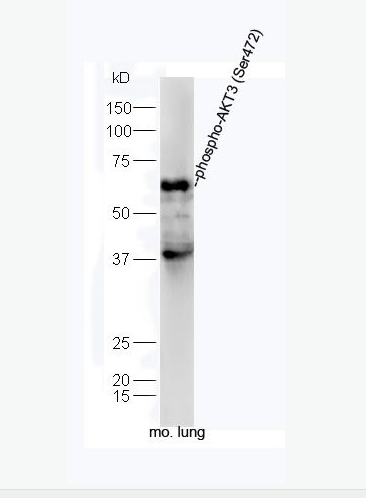| 中文名稱 | 磷酸化蛋白激酶AKT3抗體 |
| 別 名 | Akt3; AKT3 kinase; AKT3_HUMAN; DKFZp434N0250; PKB gamma; PKBG; PRKBG; Protein kinase Akt-3; Protein Kinase AKT3; Protein kinase B gamma; RAC gamma; RAC gamma serine/threonine protein kinase; RAC-gamma serine/threonine-protein kinase; RAC-PK-gamma; RACPK Gamma; Serine threonine protein kinase Akt 3; Serine threonine protein kinase Akt3; STK 2; STK-2; STK2; V akt murine thymoma viral oncogene homolog 3 protein kinase B gamma. |
| 產(chǎn)品類型 | 磷酸化抗體 |
| 研究領(lǐng)域 | 腫瘤 細(xì)胞生物 免疫學(xué) 信號(hào)轉(zhuǎn)導(dǎo) 激酶和磷酸酶 |
| 抗體來(lái)源 | Rabbit |
| 克隆類型 | Polyclonal |
| 交叉反應(yīng) | Human, Mouse, Rat, (predicted: Chicken, Dog, Pig, Cow, Rabbit, Sheep, ) |
| 產(chǎn)品應(yīng)用 | WB=1:500-2000 ELISA=1:500-1000 IHC-P=1:100-500 IHC-F=1:100-500 IF=1:100-500 (石蠟切片需做抗原修復(fù)) not yet tested in other applications. optimal dilutions/concentrations should be determined by the end user. |
| 分 子 量 | 56kDa |
| 細(xì)胞定位 | 細(xì)胞核 細(xì)胞漿 細(xì)胞膜 |
| 性 狀 | Liquid |
| 濃 度 | 1mg/ml |
| 免 疫 原 | KLH conjugated Synthesised phosphopeptide derived from human AKT3 around the phosphorylation site of Ser472:QF(p-S)YS |
| 亞 型 | IgG |
| 純化方法 | affinity purified by Protein A |
| 儲(chǔ) 存 液 | 0.01M TBS(pH7.4) with 1% BSA, 0.03% Proclin300 and 50% Glycerol. |
| 保存條件 | Shipped at 4℃. Store at -20 °C for one year. Avoid repeated freeze/thaw cycles. |
| PubMed | PubMed |
| 產(chǎn)品介紹 | Akt, protein kinase B (PKB), is a serine/threonine kinase which is involved in many cellular signaling pathways and acts as a transducer of many functions initiated by growth factor receptors that activate phosphtidylinositol 3 kinase (PI 3 kinase). The major activity of Akt/PKB is to mediate cell survival. Akt/PKB is also believed to be a critical factor in the genesis of cancer as the tumor suppressor PTEN was found to antagonise PI3 kinase and Akt/PKB kinase activity. There are 3 known isoforms of this enzyme in mammalian cells (1/alpha, 2/beta and 3/gamma). IGF1 leads to the activation of AKT3, which may play a role in regulating cell survival. It is capable of phosphorylating several known proteins. Function: AKT3 is one of 3 closely related serine/threonine-protein kinases (AKT1, AKT2 and AKT3) called the AKT kinase, and which regulate many processes including metabolism, proliferation, cell survival, growth and angiogenesis. This is mediated through serine and/or threonine phosphorylation of a range of downstream substrates. Over 100 substrate candidates have been reported so far, but for most of them, no isoform specificity has been reported. AKT3 is the least studied AKT isoform. It plays an important role in brain development and is crucial for the viability of malignant glioma cells. AKT3 isoform may also be the key molecule in up-regulation and down-regulation of MMP13 via IL13. Required for the coordination of mitochondrial biogenesis with growth factor-induced increases in cellular energy demands. Down-regulation by RNA interference reduces the expression of the phosphorylated form of BAD, resulting in the induction of caspase-dependent apoptosis. Subunit: Interacts (via PH domain) with TCL1A; this enhances AKT3 phosphorylation and activation. Interacts with TRAF6. Subcellular Location: Cytoplasm. Nucleus. Cell membrane. Note=Nucleus after activation by integrin-linked protein kinase 1 (ILK1). Nuclear translocation is enhanced by interaction with TCL1A. Phosphorylation on Tyr-176 by TNK2 results in its localization to the cell membrane where it is targeted for further phosphorylations on Thr-308 and Ser-473 leading to its activation and the activated form translocates to the nucleus. Tissue Specificity: In adult tissues, it is highly expressed in brain, lung and kidney, but weakly in heart, testis and liver. In fetal tissues, it is highly expressed in heart, liver and brain and not at all in kidney. Post-translational modifications: Phosphorylation on Thr-305 and Ser-472 is required for full activity (By similarity). Ubiquitinated. When fully phosphorylated and translocated into the nucleus, undergoes 'Lys-48'-polyubiquitination catalyzed by TTC3, leading to its degradation by the proteasome. O-GlcNAcylation at Thr-302 and Thr-309 inhibits activating phosphorylation at Thr-305 via disrupting the interaction between AKT and PDK1 (By similarity). DISEASE: Note=AKT3 is a key modulator of several tumors like melanoma, glioma and ovarian cancer. Active AKT3 increases progressively during melanoma tumor progression with highest levels present in advanced-stage metastatic melanomas. Promotes melanoma tumorigenesis by decreasing apoptosis. Plays a key role in the genesis of ovarian cancers through modulation of G2/M phase transition. With AKT2, plays a pivotal role in the biology of glioblastoma. Megalencephaly-polymicrogyria-polydactyly-hydrocephalus syndrome (MPPH) [MIM:603387]: A syndrome characterized by megalencephaly, hydrocephalus, and polymicrogyria; polydactyly may also be seen. There is considerable phenotypic similarity between this disorder and the megalencephaly-capillary malformation syndrome. Note=The disease is caused by mutations affecting the gene represented in this entry. Similarity: Belongs to the protein kinase superfamily. AGC Ser/Thr protein kinase family. RAC subfamily. Contains 1 AGC-kinase C-terminal domain. Contains 1 PH domain. Contains 1 protein kinase domain. SWISS: Q9Y243 Gene ID: 10000 Database links: Entrez Gene: 10000 Human Entrez Gene: 23797 Mouse Entrez Gene: 29414 Rat Omim: 611223 Human SwissProt: Q9Y243 Human SwissProt: Q9WUA6 Mouse SwissProt: Q63484 Rat Unigene: 498292 Human Unigene: 235194 Mouse Unigene: 10506 Rat Important Note: This product as supplied is intended for research use only, not for use in human, therapeutic or diagnostic applications. |
| 產(chǎn)品圖片 |  Sample: Lung (Mouse) Lysate at 40 ug Sample: Lung (Mouse) Lysate at 40 ugPrimary: Anti-phospho-AKT3 (Ser472) (bs-5209R) at 1/300 dilution Secondary: HRP conjugated Goat-Anti-rabbit IgG (bs-0295G-HRP) at 1/5000 dilution Predicted band size: 56 kD Observed band size: 56 kD 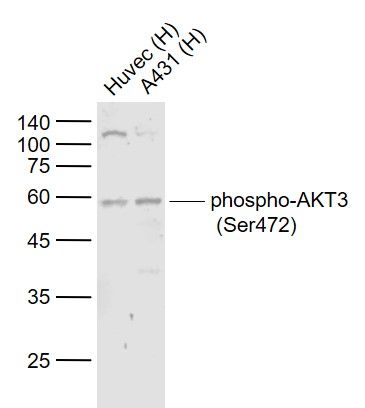 Sample: Sample:Lane 1: Huvec (Human) Cell Lysate at 30 ug Lane 2: A431 (Human) Cell Lysate at 30 ug Primary: Anti-phospho-AKT3 (Ser472) (bs-5209R) at 1/1000 dilution Secondary: IRDye800CW Goat Anti-Rabbit IgG at 1/20000 dilution Predicted band size: 60 kD Observed band size: 58 kD 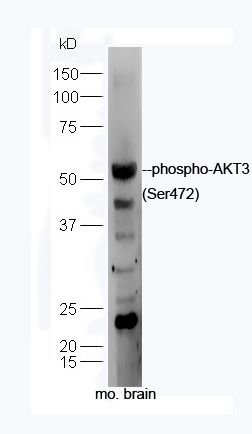 Sample: Sample:brain (Mouse) Lysate at 40 ug Primary: Anti-phospho-AKT3 (Ser472) (bs-5209R) at 1/300 dilution Secondary: IRDye800CW Goat Anti-Rabbit IgG at 1/20000 dilution Predicted band size: 56 kD Observed band size: 56 kD 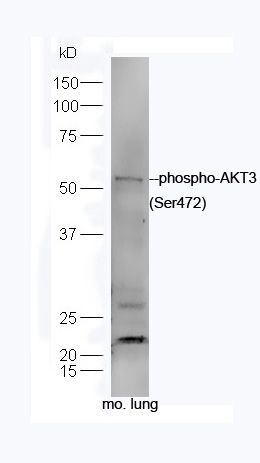 Sample: Sample:Lung (Mouse) Lysate at 40 ug Primary: Anti-phospho-AKT3 (Ser472) (bs-5209R) at 1/300 dilution Secondary: IRDye800CW Goat Anti-Rabbit IgG at 1/20000 dilution Predicted band size: 56 kD Observed band size: 56 kD 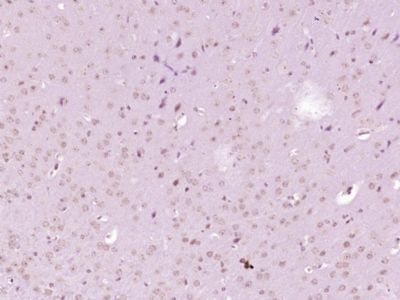 Paraformaldehyde-fixed, paraffin embedded (Mouse brain); Antigen retrieval by boiling in sodium citrate buffer (pH6.0) for 15min; Block endogenous peroxidase by 3% hydrogen peroxide for 20 minutes; Blocking buffer (normal goat serum) at 37°C for 30min; Antibody incubation with (phospho-AKT3 (Ser472)) Polyclonal Antibody, Unconjugated (bs-5209R) at 1:400 overnight at 4°C, followed by operating according to SP Kit(Rabbit) (sp-0023) instructionsand DAB staining. Paraformaldehyde-fixed, paraffin embedded (Mouse brain); Antigen retrieval by boiling in sodium citrate buffer (pH6.0) for 15min; Block endogenous peroxidase by 3% hydrogen peroxide for 20 minutes; Blocking buffer (normal goat serum) at 37°C for 30min; Antibody incubation with (phospho-AKT3 (Ser472)) Polyclonal Antibody, Unconjugated (bs-5209R) at 1:400 overnight at 4°C, followed by operating according to SP Kit(Rabbit) (sp-0023) instructionsand DAB staining.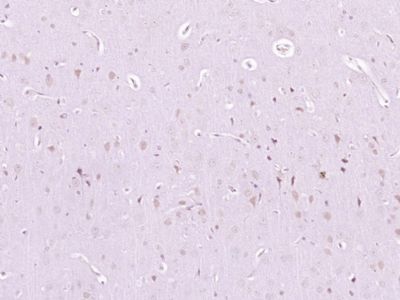 Paraformaldehyde-fixed, paraffin embedded (Rat brain); Antigen retrieval by boiling in sodium citrate buffer (pH6.0) for 15min; Block endogenous peroxidase by 3% hydrogen peroxide for 20 minutes; Blocking buffer (normal goat serum) at 37°C for 30min; Antibody incubation with (phospho-AKT3 (Ser472)) Polyclonal Antibody, Unconjugated (bs-5209R) at 1:400 overnight at 4°C, followed by operating according to SP Kit(Rabbit) (sp-0023) instructionsand DAB staining. Paraformaldehyde-fixed, paraffin embedded (Rat brain); Antigen retrieval by boiling in sodium citrate buffer (pH6.0) for 15min; Block endogenous peroxidase by 3% hydrogen peroxide for 20 minutes; Blocking buffer (normal goat serum) at 37°C for 30min; Antibody incubation with (phospho-AKT3 (Ser472)) Polyclonal Antibody, Unconjugated (bs-5209R) at 1:400 overnight at 4°C, followed by operating according to SP Kit(Rabbit) (sp-0023) instructionsand DAB staining.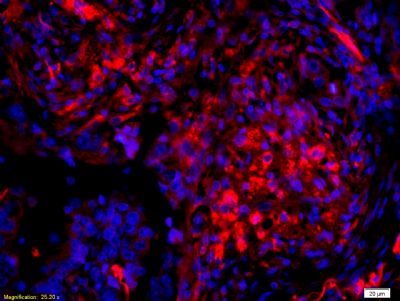 Tissue/cell: human lung carcinoma;4% Paraformaldehyde-fixed and paraffin-embedded; Tissue/cell: human lung carcinoma;4% Paraformaldehyde-fixed and paraffin-embedded;Antigen retrieval: citrate buffer ( 0.01M, pH 6.0 ), Boiling bathing for 15min; Blocking buffer (normal goat serum,C-0005) at 37鈩� for 20 min; Incubation: Anti-phospho-AKT3(Ser472) Polyclonal Antibody, Unconjugated(bs-5209R) 1:200, overnight at 4擄C; The secondary antibody was Goat Anti-Rabbit IgG, Cy3 conjugated (bs-0295G-Cy3)used at 1:200 dilution for 40 minutes at 37擄C. DAPI(5ug/ml,blue,C-0033) was used to stain the cell nuclei |
我要詢價(jià)
*聯(lián)系方式:
(可以是QQ、MSN、電子郵箱、電話等,您的聯(lián)系方式不會(huì)被公開(kāi))
*內(nèi)容:


